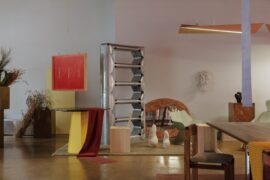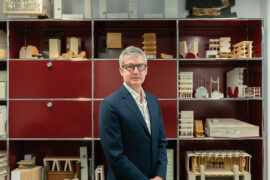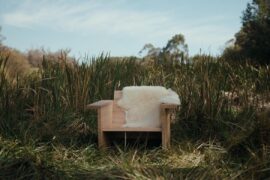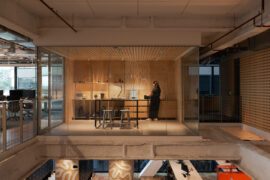Digital design and fabrication methods can generate otherwise unimaginable forms. But what will be missing if human minds and hands are expelled from the process? We ask Heatherwick Studio in Cubes 87. Here’s a preview of the article!

Rendering of an upper-level view through Vessel. Image courtesy Forbes Massie / Heatherwick Studio
August 5th, 2017
What criteria should we use when we judge emerging design and fabrication methods? What are the qualities of our material realm that we deem most valuable and worthy of preservation as we enter a new digitally enhanced era of design and coordinated machine craft? Will we continue to uphold the shepherding influence that the human mind and hand have always had in shaping our world?
I was intrigued when I heard that Heatherwick Studio’s New York project named Vessel was conceived, developed and documented with a heavy reliance on new visual scripting software. In fact, as the studio’s Group Leader Stuart Wood describes, “The project was only conceivable through the use of a computer.” Heatherwick Studio is a bastion of craft-driven design and forms tailored to the human body’s proportions. So what would a digital design process mean for the experience of the project?
Vessel, which is currently under construction at Hudson Yards, will be an extraordinary public landmark as well as a piece of infrastructure – a complex three-dimensional lattice of 2,400 steps and 80 landings in a cup-like shape reaching over 45 metres in height. It was conceived as a means of attracting and gathering people.
“It’s such a complex form that even numbering and sequencing the components would have been impossible without digital data,” he says. “But ultimately we’re interested in the real material. The digital is fascinating, but the point at which the steel is cut and the welds are created – that’s when it becomes real. That’s when you need to deploy your sensibilities of look and feel, touch and quality,” says Wood. “A computer can’t give you emotion, feel, representation.”
That’s why Wood and his team are on the factory floor making critical decisions about joints, finishes and more. “It’s been an amazing odyssey of the philosophical, the conceptual, the digital and the physical,” he says.
Read the full story in Cubes issue 87 Aug/Sept, on sale now!
INDESIGN is on instagram
Follow @indesignlive
A searchable and comprehensive guide for specifying leading products and their suppliers
Keep up to date with the latest and greatest from our industry BFF's!

London-based design duo Raw Edges have joined forces with Established & Sons and Tongue & Groove to introduce Wall to Wall – a hand-stained, “living collection” that transforms parquet flooring into a canvas of colour, pattern, and possibility.

For Aidan Mawhinney, the secret ingredient to Living Edge’s success “comes down to people, product and place.” As the brand celebrates a significant 25-year milestone, it’s that commitment to authentic, sustainable design – and the people behind it all – that continues to anchor its legacy.

Indesign Media has announced a significant milestone with the consolidation of multiple platforms into a single regional go-to source for design professionals and enthusiasts.

Hard maple is an abundant species from the American hardwood forest which is widely underused. The American Hardwood Export Council (AHEC) are endeavouring to recognise hard maple’s true potential in design, particularly as a link between the home and the natural world.
The internet never sleeps! Here's the stuff you might have missed

The inaugural Adelaide Design Week *everywhere unfolded across five days and nights, bringing together the creative community in a way that hadn’t happened before. Organiser and regular contributor Bronwyn Marshall gives us the inside story.

Leading by design, Erik L’Heureux has recently taken the helm of Monash University’s Department of Architecture, and so a new and exciting journey begins for both L’Heureux and the University.

Mark Tuckey X Main Studio embrace the future with a new range of furniture that showcases the beauty of agroforestry timber.

The Arup Workplace in Perth/Boorloo, designed by Hames Sharley with Arup and Peter Farmer Designs, has been awarded The Work Space at the INDE.Awards 2025. Recognised for its regenerative design, cultural authenticity, and commitment to sustainability, the project sets a new benchmark for workplace architecture in the Indo–Pacific region.